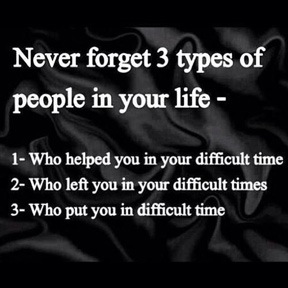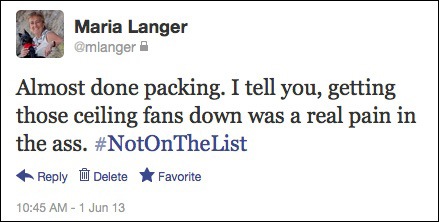Stop wasting time chasing likes and accumulating followers and “friends.”
 Today, my friend Andy started a job at Twitter.
Today, my friend Andy started a job at Twitter.
Andy and I met a little over seven years ago on Twitter. He, in fact, was the first person I followed there.
Back in those days, Twitter was only a year or so old and no one really “got it” yet. Actually, I don’t even think the folks who made Twitter got it. They promoted it as a “microblogging” platform, a place to share very brief comments with others. Did they ever dream that it would become what it has become? A valuable and timely source of news and information? The world’s “water cooler” for chatting, venting, and sharing?
This morning, when Andy announced that he was tweeting from Twitter’s U.K. headquarters, I realized that not only had we met on Twitter, but that Twitter had become a source of our livelihoods. Andy works at Twitter now, so he’s on their payroll. And I’ve written courses for Lynda.com about Twitter, so I get royalties for sharing my Twitter knowledge.
Funny how that worked out, no?
The Frustration of Facebook
 I really don’t like Facebook, but like so many of my friends, I find myself drawn to it. It has so much potential to be a truly valuable social networking service and enough of my friends understand that to make it worth visiting.
I really don’t like Facebook, but like so many of my friends, I find myself drawn to it. It has so much potential to be a truly valuable social networking service and enough of my friends understand that to make it worth visiting.
But at the same time, I find it immensely frustrating, mostly because of the number of people who just don’t seem to get it. I let some of that frustration out the other day after reading a post by one of my friends — coincidentally, someone else I met on Twitter — that proved how little she understood the “social” aspect of social networking.
She’d shared a humorous photo that had made the rounds at least two weeks before, presenting it as if it were something new. It wouldn’t have bothered me so much except for three things: (1) she considers herself a social networking “expert,” (2) her accompanying commentary clearly indicated she thought she was so clever for finding and sharing the image, and (3) I know she’s friends with at least one of the people who’d shared the photo when it made its original rounds so she should have seen it when the rest of us did. It’s this last point that bothered me most: she obviously wasn’t looking at anything that the rest of us shared. She was just posting whatever she found.
And posting and posting. Dozens of Facebook status updates with links and images every day, about half of which I’d already seen days or weeks before.
For some reason, Friday’s post was like the straw that broke the camel’s back. I posted a status update that said:
If some people would READ their Facebook timeline as much as they POST to it, they’d discover that about 50% of what they post as new and novel was shared by their friends on Facebook 2 weeks ago. #JustSaying #FunnyThenNotNow
I know I wasn’t completely off-base because 12 people “liked” it. That’s slightly above average for a status update that doesn’t include a photo. (More on that in a moment.) But one of my friends commented to say, “Wow…that’s kind of mean.” And another one added, “New, novel, Facebook all in one thought? Oxymoron there fly lady. Think it’s vacation time. Don’t pack the cranky pants.”
And that’s when I realized I needed a break from Facebook. So I pretty much took the weekend off.
Chasing Likes, Follows, and Friends
I began to realize a few years ago that a lot of people were using social media as a way to stroke their personal or business egos. (Hell, it’s a lot easier than blogging, which actually requires you to come up with original content.) I think that realization hit me when I heard about Klout. That’s a social media monitoring service that tells you how “influential” you are. Your Klout score is a number and apparently a lot of people who should have more important things to think about think their Klout score is vitally important.
I’m not sure how you build up your Klout score. I’m not sure because I don’t care. I don’t have the faintest idea of what mine is. From the way people talk, I suspect it has to do with how many Twitter followers and Facebook friends and LinkedIn connections you have and how many Google+ users — yes, there really are some — have you in their circles. It probably also takes into consideration things like retweets, likes, and shares — at least it should.
One of my pet peeves with certain Twitter users is the way they retweet content by copying and pasting tweets instead of using Twitter’s built-in retweet feature. What they’re doing is hijacking content. Even if the author’s name appears in the tweet (usually after RT), the hijacker’s account is the one that appears when it’s subsequently properly retweeted by others. It’s like taking credit for someone else’s comment or link or photo.
It’s a slime bag way to use Twitter for self-promotion.
And if you don’t know what I’m talking about and want to learn, read this.
As a result, to some people it becomes vitally important to accumulate followers, friends, connections, and circlers (or whatever Google+ calls the people who supposedly monitor your activity). And it’s equally important to post new content on the social networks with the ultimate goal of attracting attention to pump up that Klout score. So lots of these people post all kinds of things all day long.
I guess they figure that if you throw enough crap at a wall, some of it’s gotta stick.
Or maybe they just assume that everyone who follows them on social media does it they way they do: a quick glance a few times a week to see what others are saying. They figure that if they post a ton of stuff, something will be seen. So they go after quantity and not quality.
Of course, there are dozens of “viral” websites cropping up every day to provide content that’ll get social networkers the likes and shares they crave. Any site with the word “viral” or “share” in its name exists solely for that purpose. They have staffs who comb the web for interesting or amusing content and repackage it on their sites surrounded by dozens of ads. They write headlines designed to hook bored readers and drag them in. You’ve seen them: “This second grader’s revenge against Common Core math will make your day” and “Bella Thorne Suffers “Major Wardrobe Malfunction” at Nickelodeon Kids’ Choice Awards: Picture.”

How many of these do you see on Facebook every day? Too many, I’ll bet.
Then there are the lists: “16 Alarming Airline Secrets That Will Change How You Feel About Flying.” Or the simpler lists that just appear in images.
And the inspirational quotes, superimposed over (often inappropriate) photos.

I didn’t share this. What does that really mean? That I don’t love my mother? Or that I don’t want to clutter up my friends’ news feeds with idiotic crap?
And the short stories of friendship or love or faith — that end with a statement implying that you’re uncaring S.O.B. if you don’t share it with everyone you know on Facebook.
This is the (mostly) crap people are “sharing” in search of likes and shares and retweets. And the people who share this (mostly) crap don’t understand that they are being manipulated into promoting websites that have hijacked content solely so the hijacker sites can get hits and maximize ad revenue.
And Facebook doesn’t help matters. Instead of showing me everything that the people I follow post on their own timelines — like Twitter does quite faithfully — it uses some mystery algorithm to determine what appears, what order to put it in, and how many times to show it. So I wind up missing half the content posted by the people who tend to share interesting stuff and get stuck looking at a lot of crap because my friends happened to comment on one of their friends’ mindless drivel.
Social Is More than Sharing
It’s all about likes and retweets and favorites. Apparently, that’s what most people want. It’s a good thing, too. Because most people can’t be bothered to participate any more than with a simple click on an icon indicating their approval.
Deep discussion is rare. Very rare. I’m fortunate that I follow a few interesting and thoughtful people and they follow me. I’m fortunate to get the few exchanges of comments and ideas that I get. I know that now.
But it still frustrates me.
How can something be social when there’s no real interaction between people? I post a photo, 20 people click a like button. Is that a real “social” activity? (Tip: Updates with photos are far more likely to get “likes” than those without.)
I share a link to an article Hobby Lobby trying to use a claim of “conscientious objection” to avoid providing health care to employees that includes birth control coverage and I don’t get a single comment. Is it possible that no one has anything to say about this?
(And don’t get me started on the people who do comment based on an article’s headline but obviously haven’t read the article.)
Maybe the problem is what I expect from social media. I expect a two-way exchange. I expect civil discourse, conversation to carry an idea forward or sideways or simply expand it.
That’s why I got hooked on Twitter so quickly — I was building relationships with people there. These people were keeping me company throughout my work day, when I was stuck in a home office in front of a computer. They were there when I needed a break. They were my water cooler companions.
There were plenty of two-way exchanges. I was even meeting Twitter friends in the flesh — I remain very good friends with more than a few.
To me, that’s what social networking is all about: making and communicating with friends.
It’s social.
Real People, Real Friendships
Andy lives in the U.K. I’ve never met him in person; I’ve never even spoken to him on the phone or on Skype. Yet I know that he’s a techie, he loves Lego, and he’s been through a divorce. He’s someone I can communicate with every day, the guy I can find at the “water cooler” and exchange links, comments, and gripes with.
There’s a pretty good chance I’ll meet Andy in person in April. He’s coming to Twitter headquarters for some orientation. I’m in the Sacramento area with a wide-open schedule. I’ll work my schedule to meet his.
To me, social networking is social. It’s an exchange of information and ideas — an exchange that works two ways. I’ve built good friendships with the folks who understand that, folks like Andy who see how social networking can truly enrich our lives.







